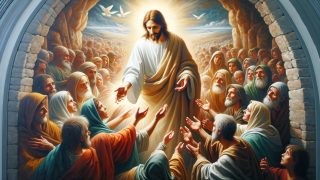

Introduction: The birth of Jesus Christ is a cornerstone event in the Christian faith, symbolizing the arrival of the Son of God on Earth. Celebrated globally on December 25th, the nativity story holds deep significance, not only within religious circles but also in cultural and historical contexts. Understanding the narrative of Jesus’ birth requires delving into the Gospels of the New Testament, examining historical records, and exploring the cultural milieu of the time.
The Gospel Accounts: The primary sources for the story of Jesus’ birth are found in the Gospels of Matthew and Luke. Each account provides unique perspectives and details surrounding the events leading up to and following the birth.
Matthew’s Gospel emphasizes the genealogy of Jesus, tracing his lineage back to Abraham and highlighting his connection to the Davidic line. The narrative depicts the visit of the Magi, wise men from the East, who follow a star to Bethlehem, where they pay homage to the newborn king by presenting gifts of gold, frankincense, and myrrh.

Luke’s Gospel, on the other hand, focuses on the circumstances of Jesus’ birth in Bethlehem. It describes the journey of Mary and Joseph from Nazareth to Bethlehem, Mary’s virgin conception through the Holy Spirit, and the humble setting of Jesus’ birth in a manger. Luke also introduces the shepherds, who receive the angelic proclamation of Jesus’ birth and visit the newborn in Bethlehem.
Historical Context: The nativity story unfolds against the backdrop of the Roman Empire’s rule over Judea. Caesar Augustus’s decree for a census, mentioned in Luke’s Gospel, serves as the catalyst for Mary and Joseph’s journey to Bethlehem. This historical detail underscores the political and social realities of the time, positioning Jesus’ birth within a specific historical framework.
Cultural Significance: The nativity story has inspired centuries of artistic representation, music, literature, and cultural traditions. Nativity scenes, depicting the infant Jesus surrounded by Mary, Joseph, the shepherds, and the Magi, are a ubiquitous feature of Christmas celebrations worldwide. Carols such as “Silent Night” and “O Holy Night” capture the reverence and joy associated with the birth of Christ.
Theological Implications: From a theological perspective, the incarnation of Jesus—his embodiment of divine nature in human form—lies at the heart of the nativity narrative. The concept of Emmanuel, meaning “God with us,” encapsulates the belief that Jesus’ birth inaugurates God’s presence and salvation among humanity.
Conclusion: The nativity of Jesus Christ remains a foundational tenet of Christian faith, symbolizing hope, redemption, and divine intervention. Through the convergence of historical accounts, cultural symbolism, and theological significance, the story of Jesus’ birth continues to resonate across diverse religious and cultural landscapes, serving as a timeless reminder of the profound mystery of the Incarnation.






Hello! Do you use Twitter? I’d like to follow you if that would be okay.
I’m absolutely enjoying your blog and look forward to new posts.
Way cool! Some very valid points! I appreciate you penning this write-up and the rest of the site is also
very good.
I really like your blog.. very nice colors & theme. Did you create this website yourself or did you hire someone to do it for you?
Plz reply as I’m looking to create my own blog and would like to know where u got this from.
cheers
Hello, everything is going perfectly here and ofcourse every one
is sharing information, that’s in fact fine, keep up writing.
Thanks very nice blog!
I have read so many posts on the topic of the blogger lovers but this post is
genuinely a good post, keep it up.
This is very fascinating, You’re an excessively professional blogger.
I’ve joined your feed and look forward to searching for extra of your fantastic post.
Also, I’ve shared your web site in my social networks
I’ve been visiting this site for years, and it never fails to impress me with its fresh perspectives and wealth of knowledge. The attention to detail and commitment to quality is evident. This is a true asset for anyone seeking to learn and grow.
I’ve been visiting this site for years, and it never fails to impress me with its fresh perspectives and wealth of knowledge. The attention to detail and commitment to quality is evident. This is a true asset for anyone seeking to learn and grow.